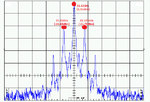Eres_89
Member level 1
Hi All,
Some time ago, I designed simple hartley tunable oscillator working in range 21-23 GHz band (like this presented in attachment - diode is working as a tuned capacitance in resonance circuit). How big was my surprise when during measurements I observed additional products in frequency spectrum. It's look like effect of mixing two signals ! (like in modulation process). Now I'm wondering where is cause of such behaviour and I don't have any practical idea what is going on... There are no other measured signals in band from 1Hz to 30GHz so it's look like circuit issue.
Bellow I attach measured spectrum with frequencies marked.

I'll be really appreciate for any suggestion where I should search for answer.
Regards,
E.

Some time ago, I designed simple hartley tunable oscillator working in range 21-23 GHz band (like this presented in attachment - diode is working as a tuned capacitance in resonance circuit). How big was my surprise when during measurements I observed additional products in frequency spectrum. It's look like effect of mixing two signals ! (like in modulation process). Now I'm wondering where is cause of such behaviour and I don't have any practical idea what is going on... There are no other measured signals in band from 1Hz to 30GHz so it's look like circuit issue.
Bellow I attach measured spectrum with frequencies marked.

I'll be really appreciate for any suggestion where I should search for answer.
Regards,
E.
